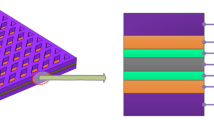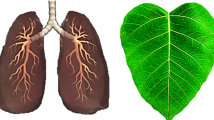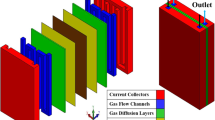Abstract
Designing bio-inspired flow fields holds great potential in improving the performance of Proton Exchange Membrane Fuel Cell (PEMFC). Two kinds of biological prototypes are widely used: plant prototype and animal prototype. It remains a question which one of these prototypes is more appropriate for the scenario of PEMFC. Here, a comparative study was conducted to compare bionic flow fields based on animal and plant prototypes. First, a Corn Leaf Vein Mathematical Model (CLMM) was established by extracting structural parameters from corn leaves of two growth stages. Then the obtained CLMM and well-known Murray’s law were employed to design bionic flow fields corresponding to the plant and animal prototypes, respectively, which have been subsequently compared by numerical investigations. The results demonstrate that the flow field guided by Murray’s law outperforms the counterpart based on the structural parameters of CLMM in terms of PEMFC net output power, mass transport, water management and pressure drop, suggesting that animal circulation system is more suitable to the bionic flow field design of PEMFC than plant leaf veins. The work may also offer valuable insights into the design of other flow fields related to electrochemical energy conversion.













Similar content being viewed by others
References
Sharaf, O. Z., & Orhan, M. F. (2014). An overview of fuel cell technology: Fundamentals and applications. Renewable and Sustainable Energy Reviews, 32, 810–853.
Jiao, K., Xuan, J., Du, Q., Bao, Z. M., Xie, B., Wang, B. W., Zhao, Y., Fan, L. H., Wang, H. Z., Hou, Z. J., Huo, S., Brandon, N. P., Yin, Y., & Guiver, M. D. (2021). Designing the next generation of proton-exchange membrane fuel cells. Nature, 595, 361–369.
Kahraman, H., & Orhan, M. F. (2017). Flow field bipolar plates in a proton exchange membrane fuel cell: Analysis & modeling. Energy Conversion and Management, 133, 363–384.
Wilberforce, T., El Hassan, Z., Ogungbemi, E., Ijaodola, O., Khatib, F. N., Durrant, A., Thompson, J., Baroutaji, A., & Olabi, A. G. (2019). A comprehensive study of the effect of bipolar plate (BP) geometry design on the performance of proton exchange membrane (PEM) fuel cells. Renewable and Sustainable Energy Reviews, 111, 236–260.
Marappan, M., Palaniswamy, K., Velumani, T., Chul, K. B., Velayutham, R., Shivakumar, P., & Sundaram, S. (2021). Performance studies of proton exchange membrane fuel cells with different flow field designs – review. The Chemical Record, 21, 663–714.
Korkischko, I., Carmo, B. S., & Fonseca, F. C. (2017). Shape optimization of PEMFC flow-channel cross-sections. Fuel Cells, 17, 809–815.
Mohammedi, A., Sahli, Y., & Moussa, H. B. (2020). 3D investigation of the channel cross-section configuration effect on the power delivered by PEMFCs with straight channels. Fuel, 263, 116713.
André, J., Claude, E., Sirac, D., Gastaldin, D., & Rossinot, E. (2020). PEMFC flow-field design, channel/land width ratio optimization. Fuel Cells, 20, 231–235.
Kerkoub, Y., Benzaoui, A., Haddad, F., & Ziari, Y. K. (2018). Channel to rib width ratio influence with various flow field designs on performance of PEM fuel cell. Energy Conversion and Management, 174, 260–275.
Selvaraj, A. S., & Rajagopal, T. K. R. (2020). Numerical investigation on the effect of flow field and landing to channel ratio on the performance of PEMFC. International Journal of Energy Research, 44, 171–191.
Li, W. Z., Yang, W. W., Wang, N., Jiao, Y. H., Yang, Y., & Qu, Z. G. (2020). Optimization of blocked channel design for a proton exchange membrane fuel cell by coupled genetic algorithm and three-dimensional CFD modeling. International Journal of Hydrogen Energy, 45, 17759–17770.
Yin, Y., Wu, S. Y., Qin, Y. Z., Otoo, O. N., & Zhang, J. F. (2020). Quantitative analysis of trapezoid baffle block sloping angles on oxygen transport and performance of proton exchange membrane fuel cell. Applied Energy, 271, 115257.
Zhang, S. Y., Qu, Z. G., Xu, H. T., Talkhoncheh, F. K., Liu, S., & Gao, Q. (2021). A numerical study on the performance of PEMFC with wedge-shaped fins in the cathode channel. International Journal of Hydrogen Energy, 46, 27700–27708.
Heidary, H., Kermani, M. J., Advani, S. G., & Prasad, A. K. (2016). Experimental investigation of in-line and staggered blockages in parallel flow field channels of PEM fuel cells. International Journal of Hydrogen Energy, 41, 6885–6893.
Wang, X. F., Qin, Y. Z., Wu, S. Y., Xiang, S. G., Zhang, J. F., & Yin, Y. (2020). Numerical and experimental investigation of baffle plate arrangement on proton exchange membrane fuel cell performance. Journal of Power Sources, 457, 228034.
Konno, N., Mizuno, S., Nakaji, H., & Ishikawa, Y. (2015). Development of compact and high-performance fuel cell stack. SAE International Journal of Alternative Powertrains, 4, 123–129.
Li, W. K., Zhang, Q. L., Wang, C., Yan, X. H., Shen, S. Y., Xia, G. F., Zhu, F. J., & Zhang, J. L. (2017). Experimental and numerical analysis of a three-dimensional flow field for PEMFCs. Applied Energy, 195, 278–288.
Shen, J., Tu, Z. K., & Chan, S. H. (2020). Performance enhancement in a proton exchange membrane fuel cell with a novel 3D flow field. Applied Thermal Engineering, 164, 114464.
Arvay, A., French, J., Wang, J. C., Peng, X. H., & Kannan, A. M. (2013). Nature inspired flow field designs for proton exchange membrane fuel cell. International Journal of Hydrogen Energy, 38, 3717–3726.
Iranzo, A., Arredondo, C. H., Kannan, A. M., & Rosa, F. (2020). Biomimetic flow fields for proton exchange membrane fuel cells: A review of design trends. Energy, 190, 116435.
Guo, N., Leu, M. C., & Koylu, U. O. (2014). Bio-inspired flow field designs for polymer electrolyte membrane fuel cells. International Journal of Hydrogen Energy, 39, 21185–21195.
Trogadas, P., Cho, J. I. S., Neville, T. P., Marquis, J., Wu, B., Brett, D. J. L., & Coppens, M. O. (2018). A lung-inspired approach to scalable and robust fuel cell design. Energy & Environmental Science, 11, 136–143.
Wen, D. H., Yin, L. Z., Piao, Z. Y., Lu, C. D., Li, G., & Leng, Q. H. (2017). A novel intersectant flow field of metal bipolar plate for proton exchange membrane fuel cell. International Journal of Energy Research, 41, 2184–2193.
Dong, J. H., Liu, S. F., & Liu, S. H. (2020). Numerical investigation of novel bio-inspired flow field design scheme for PEM fuel cell. Journal of Renewable and Sustainable Energy, 12, 044303.
Çelik, E., & Karagöz, İ. (2020). Polymer electrolyte membrane fuel cell flow field designs and approaches for performance enhancement. Proceedings of the Institution of Mechanical Engineers, Part A: Journal of Power and Energy, 234, 1189–1214.
Cho, J. I. S., Neville, T. P., Trogadas, P., Bailey, J., Shearing, P., Brett, D. J. L., & Coppens, M. O. (2018). Capillaries for water management in polymer electrolyte membrane fuel cells. International Journal of Hydrogen Energy, 43, 21949–21958.
Dong, J., Xu, X. H., & Xu, B. (2017). CFD analysis of a novel modular manifold with multi-stage channels for uniform air distribution in a fuel cell stack. Applied Thermal Engineering, 124, 286–293.
Zheng, X. F., Shen, G. F., Wang, C., Li, Y., Dunphy, D., Hasan, T., Brinker, C. J., & Su, B. L. (2017). Bio-inspired Murray materials for mass transfer and activity. Nature Communications, 8, 14921.
Sauermoser, M., Kizilova, N., Pollet, B. G., & Kjelstrup, S. (2020). Flow field patterns for proton exchange membrane fuel cells. Frontiers in Energy Research, 8, 13.
Xiong, K. N., Wu, W., Wang, S. F., & Zhang, L. (2021). Modeling, design, materials and fabrication of bipolar plates for proton exchange membrane fuel cell: A review. Applied Energy, 301, 117443.
Murray, C. D. (1926). The physiological principle of minimum work applied to the angle of branching of arteries. Journal of General Physiology, 9, 835–841.
Xu, P., Sasmito, A. P., Yu, B. M., & Mujumdar, A. S. (2016). Transport phenomena and properties in treelike networks. Applied Mechanics Reviews, 68, 040802.
Ji, Y. D., Ding, X. H., Li, H., & Xiong, M. (2018). Layout design of conductive heat channel by emulating natural branch systems. Journal of Bionic Engineering, 15, 567–578.
Sack, L., & Scoffoni, C. (2013). Leaf venation: Structure, function, development, evolution, ecology and applications in the past, present and future. New Phytologist, 198, 983–1000.
Ye, H., Yuan, Z., & Zhang, S. Q. (2013). The heat and mass transfer analysis of a leaf. Journal of Bionic Engineering, 10, 170–176.
Pirozzoli, S. (2018). On turbulent friction in straight ducts with complex cross-section: The wall law and the hydraulic diameter. Journal of Fluid Mechanics, 846, R1.
Um, S., & Wang, C. Y. (2004). Three-dimensional analysis of transport and electrochemical reactions in polymer electrolyte fuel cells. Journal of Power Sources, 125, 40–51.
Yuan, W., Tang, Y., Pan, M. Q., Li, Z. T., & Tang, B. (2010). Model prediction of effects of operating parameters on proton exchange membrane fuel cell performance. Renewable Energy, 35, 656–666.
Li, H. W., Xu, B. S., Lu, G. L., Du, C. H., & Huang, N. (2021). Multi-objective optimization of PEM fuel cell by coupled significant variables recognition, surrogate models and a multi-objective genetic algorithm. Energy Conversion and Management, 236, 114063.
Sassin, M. B., Garsany, Y., Atkinson, R. W., Hjelm, R. M. E., & Swider-Lyons, K. E. (2019). Understanding the interplay between cathode catalyst layer porosity and thickness on transport limitations en route to high-performance PEMFCs. International Journal of Hydrogen Energy, 44, 16944–16955.
Iranzo, A., Muñoz, M., Rosa, F., & Pino, J. (2010). Numerical model for the performance prediction of a PEM fuel cell. Model results and experimental validation. International Journal of Hydrogen Energy, 35, 11533–11550.
Atyabi, S. A., & Afshari, E. (2019). Three-dimensional multiphase model of proton exchange membrane fuel cell with honeycomb flow field at the cathode side. Journal of Cleaner Production, 214, 738–748.
Sierra, J. M., Figueroa-Ramírez, S. J., Díaz, S. E., Vargas, J., & Sebastian, P. J. (2014). Numerical evaluation of a PEM fuel cell with conventional flow fields adapted to tubular plates. International Journal of Hydrogen Energy, 39, 16694–166705.
Li, W. Z., Yang, W. W., Zhang, W. Y., Qu, Z. G., & He, Y. L. (2019). Three-dimensional modeling of a PEMFC with serpentine flow field incorporating the impacts of electrode inhomogeneous compression deformation. International Journal of Hydrogen Energy, 44, 22194–22209.
Lorenzini-Gutierrez, D., Hernandez-Guerrero, A., Ramos-Alvarado, B., Perez-Raya, I., & Alatorre-Ordaz, A. (2013). Performance analysis of a proton exchange membrane fuel cell using tree-shaped designs for flow distribution. International Journal of Hydrogen Energy, 38, 14750–14763.
Ferng, Y. M., & Su, A. (2007). A three-dimensional full-cell CFD model used to investigate the effects of different flow channel designs on PEMFC performance. International Journal of Hydrogen Energy, 32, 4466–4476.
Zhang, G. B., Fan, L. H., Sun, J., & Jiao, K. (2017). A 3D model of PEMFC considering detailed multiphase flow and anisotropic transport properties. International Journal of Heat and Mass Transfer, 115, 714–724.
Fan, L. H., Niu, Z. Q., Zhang, G. B., & Jiao, K. (2018). Optimization design of the cathode flow channel for proton exchange membrane fuel cells. Energy Conversion and Management, 171, 1813–1821.
Springer, T. E., Zawodzinski, T. A., & Gottesfeld, S. (1991). Polymer electrolyte fuel cell model. Journal of The Electrochemical Society, 138, 2334–2342.
Chen, D. F., Zou, Y. T., Shi, W. D., Serbin, S., & You, H. L. (2021). Proton exchange membrane fuel cells using new cathode field designs of multi-inlet shunt intake design. International Journal of Energy Research, 45, 9948–9960.
Zhang, G. B., Wu, L. Z., Jiao, K., Tian, P. J., Wang, B. W., Wang, Y., & Liu, Z. (2020). Optimization of porous media flow field for proton exchange membrane fuel cell using a data-driven surrogate model. Energy Conversion and Management, 226, 113513.
He, Q., Zheng, H. F., Ma, X. L., Wang, L., Kong, H., & Zhu, Z. Y. (2022). Artificial intelligence application in a renewable energy-driven desalination system: A critical review. Energy and AI, 7, 100123.
Acknowledgements
The authors thank www.51yuansu.com for the human body image and the corn image in Fig. 4. This work was supported by the National Natural Science Foundation of China (51975245 and 52075214), Jilin Provincial Science & Technology Department (20200201058JC and 20190303039SF), Key Science and Technology R&D Projects of Jilin Province (2020C023-3), Program of Jilin University Science and Technology Innovative Research Team (2020TD-03), Youth Development Program of Jilin University (2020-JCXK-22), and the Fundamental Research Funds for the Central Universities.
Author information
Authors and Affiliations
Corresponding authors
Ethics declarations
Conflict of Interest
The authors declare no known competing interest.
Additional information
Publisher's Note
Springer Nature remains neutral with regard to jurisdictional claims in published maps and institutional affiliations.
Supplementary Information
Below is the link to the electronic supplementary material.
Rights and permissions
About this article
Cite this article
Fan, W., Zhao, T., Jiang, K. et al. Plant vs. Animal Prototype for Designing Bio-inspired PEMFC Flow Fields: Corn Veins or Murray’s Law?. J Bionic Eng 19, 761–776 (2022). https://doi.org/10.1007/s42235-022-00174-4
Received:
Revised:
Accepted:
Published:
Issue Date:
DOI: https://doi.org/10.1007/s42235-022-00174-4




